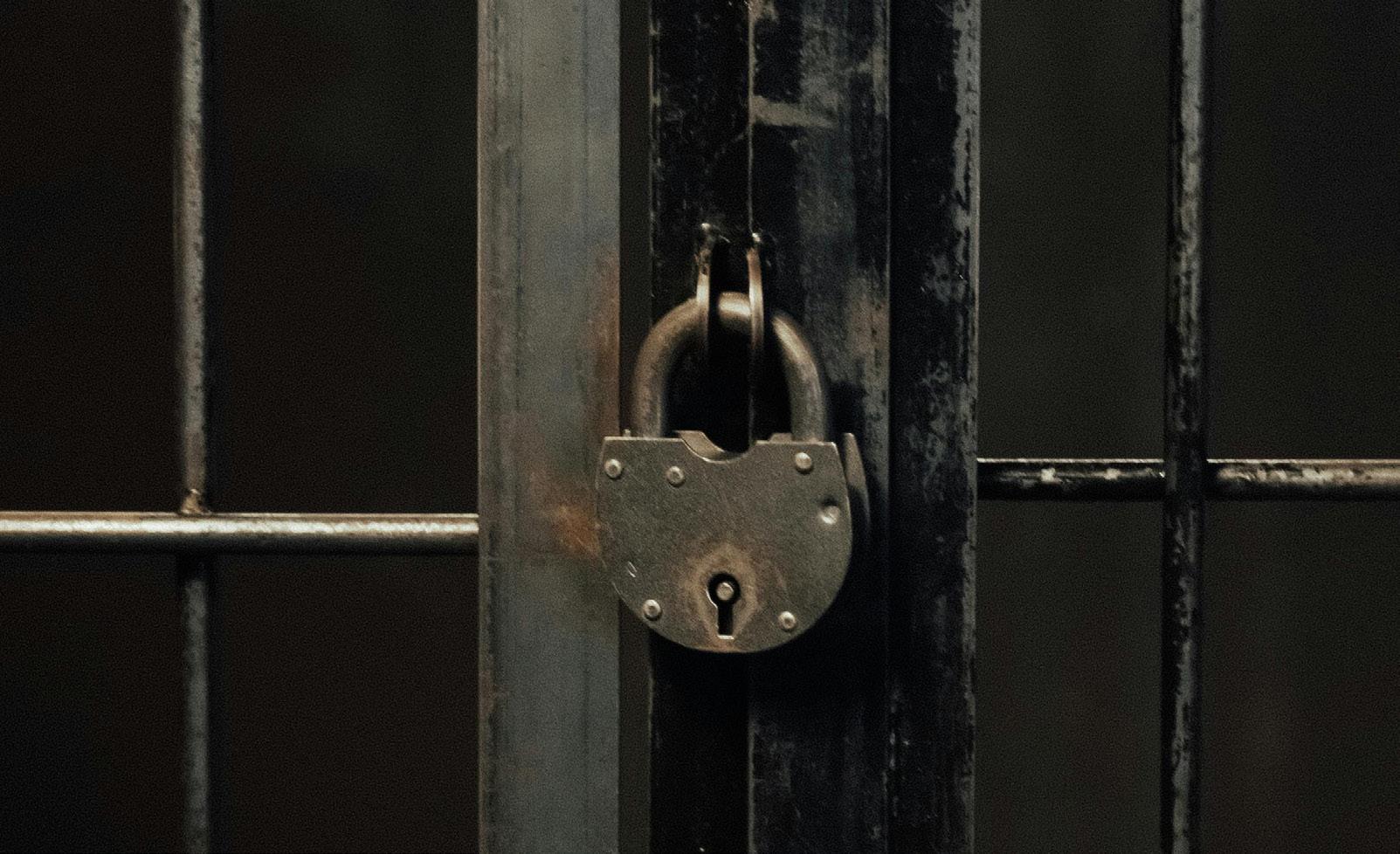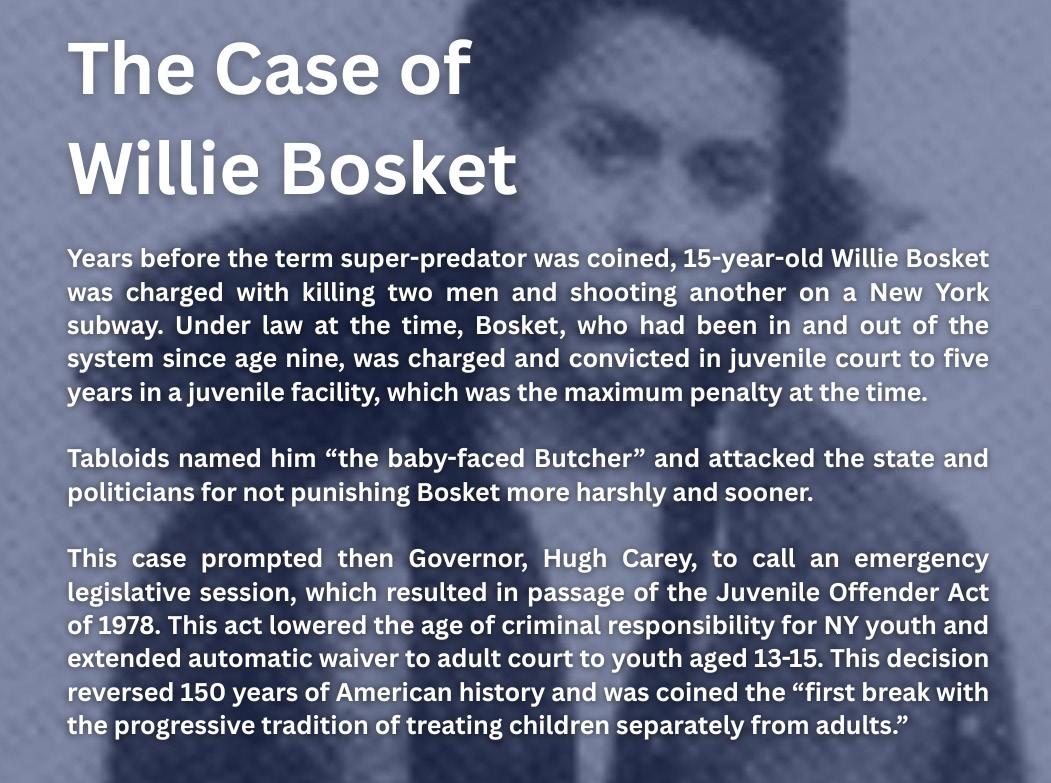Endnotes
1. Elizabeth R. Jackson-Cruz, Social Constructionism and Cultivation Theory in Development of the Juvenile “Super-Predator” 6 (Mar. 5, 2019) (M.A. thesis, University of South Florida) (on file with the Digital Commons at University of South Florida) (internal quotation omitted) (second, third, and fourth alterations in original) (quoting William J. Bennett, John J. DiIulio, Jr. & John P. Walters, Body Count: Moral Poverty… And How to Win America’s War Against Crime and Drugs 27 (Simon & Shuster, 1996), https://scholarcommons.usf. edu/cgi/viewcontent.cgi?article=9011&context=etd
2. Richard M. Southerland, Youth Matters: The Need to Treat Children Like Children, 27 J. C.R. and Econ. Dev. 765, 771 (2015).
3. Richard Lacayo, Crime: When Kids Go Bad, Time (Sept. 19, 1994), https://content.time.com/time/subscriber/ article/0,33009,981478-1,00.html (identifying Erik Menendez of Beverly Hills and Amy Fischer of Long Island as the most famous youthful offenders of the 90s).
4. Southerland, supra note 2, at 771.
5. Id. at 770.
6. John J. DiIulio, Jr., The Coming of the Super-Predators, Wkly. Standard, Nov. 27, 1995, at 23, https://archive. org/details/the-weekly-standard-1995-11-27/mode/1up.
7. Id. at 24; see also Jackson-Cruz, supra note 1, at 1.
8. DiIulio, Jr., supra note 6, at 25.
9. Id. (Defining moral poverty as “the poverty of being without loving, capable, responsible adults who teach you from wrong…growing up in the virtual absences of people who teach morality by their own everyday example and who insist that you follow suit.” In extreme cases “moral poverty is the poverty of growing up surrounded by deviant, delinquent, and criminal adults in abusive, violence-ridden, fatherless, Godless, and jobless settings.” He further reasoned that kids who are morally deprived are most likely to become criminally depraved).
10. Id. at 26.
11. Carroll Bogert & Lynnell Hancock, Superpredator: The Media Myth that Demonized a Generation of Black Youth, Marshall Project (Nov. 20, 2020) (quoting Kim Taylor Thompson, NYU Professor), https://www.themarshallproject.org/2020/11/20/superpredator-the-media-myth-that-demonized-a-generation-of-black-youth 12. Off. Juv. Just. & Delinq. Prevention, Juvenile Arrest Rate Trends, Statistical Briefing Book, https://ojjdp.ojp. gov/statistical-briefing-book/crime/faqs/jar_display#youth-arrest-rate-trends (last visited May 29, 2025).
13. Id.
14. See Jackson-Cruz, supra note 1, at 10.
15. See id
16. U.S. Dep’t of Health & Hum. Servs., Youth Violence: A Report of the Surgeon General 27 (2001), https://stacks.cdc.gov/view/cdc/7545; see also State v. Belcher, 342 Conn. 1, 258 A.3d 616, 624 (2022).
17. Elizabeth Becker, As Ex-Theorist on Young ‘Superpredators,’ Bush Aid Has Regrets, N.Y. Times (Feb. 9, 2001), https://www.nytimes.com/2001/02/09/us/as-ex-theorist-on-young-superpredators-bush-aide-has-regrets. html.
18. Id 19. Id
20. See Southerland, supra note 2, at 780; see also Howard N. Snyder & Melissa Sickmund, Nat’l Ctr. for Juv. Just., Juvenile Offenders and Victims: 1999 National Report 89 (1999), https://files.eric.ed.gov/fulltext/ ED435888.pdf.
21. Patricia Torbet et al., Off. Juv. Just. & Delinq. Prevention, State Responses to Serious and Violent Juvenile Crime 4 (1996), https://www.ojp.gov/pdffiles/statresp.pdf 22. Id.
23. Id. 24. Id.
25. See id. at 3.
26. See id. at 6.
27. John Kelly, Estimate Shows Adult Court Is Increasingly Rare Destination for Youth, The Imprint (Nov. 9, 2021), Five Decades of Child Welfare, Juvenile Justice and Party Platforms | The Imprint.
28. Josh Rovner, How Tough on Crime Became Tough on Kids: Prosecuting Teenage Drug Charges in Adult Courts, The Sentencing Project 9 (2016), How-Tough-on-Crime-Became-Tough-on-Kids.pdf (citing Bishop, D. M. (2000). Juvenile Offenders in the Adult Criminal Justice System. Crime and Justice, Vol. 27, 81-167, p. 97).
29. Off. Juv. Just. & Delinq. Prevention, Easy Access to Juvenile Court Statistics: 1985–2021, Statistical Briefing Book, https://ojjdp.ojp.gov/statistical-briefing-book/data-analysis-tools/ezajcs/demographics (last visited May 28, 2025) (filtered using the waived category under disposition).
30. U.S. Dep’t. Commerce, 1990 Census of Population General Population Characeristics United States 35 (1992), https://www2.census.gov/library/publications/decennial/1990/cp-1/cp-1-1.pdf (calculating percentages by dividing the total population of Black youth under 18 (9,584,415) by the total census population (248,709,873), and multiplying it by 100).
31. Easy Access to Juvenile Court Statistics, supra note 27.
32. Dole Seeks to Get Tough on Young Criminals, Assoc.’d Press (July 7, 1996), https://www.latimes.com/archives/la-xpm-1996-07-07-mn-22017-story.html (on file with L.A. Times Archives).
33. See id.
34. President William J. Clinton, Remarks on Signing the Violent Crime Control and Law Enforcement Act of 1994 (Sept. 13, 1994) (transcript available at The American Presidency Project).
35. Lauren-Brooke Eisen, The 1994 Crime Bill and Beyond: How Federal Funding Shapes the Criminal Justice System, Brennan Center (Sept. 9, 2019), https://www.brennancenter.org/our-work/analysis-opinion/1994-crimebill-and-beyond-how-federal-funding-shapes-criminal-justice.
36. Id.; see also Clinton, supra note 32.
37. Clinton, supra note 32.
38. Id.
39. Violent Crime Control and Law Enforcement Act of 1994, 34 U.S.C. §§ 140002-140008
40. Id. at § 20102.
41. Id.
42. Eisen, supra note 33.
43. Sherri Kimmel, The Contest for Casey’s Chair: Ridge and Singel Square Off, 16 Pa. Law. 12 (Sept. 1994).
44. Id.
45. Id
46. Hon. John B. Leete, Treatment and Rehabilitation or Hard Time: Is the Focus of Juvenile Justice Changing?, 29 Akron L. Rev. 491, 493 (1996).
47. Robert B. Acton, Gubernatorial Initiatives and Rhetoric of Juvenile Justice Reform, 5 J.L. & Pol’y 277, 280 (1996) (citing Governor Tom Ridge, Address to the Joint Session of the Pennsylvania General Assembly 4 (Jan. 23, 1994)) (transcript on file with Journal of Law and Policy). (https://brooklynworks.brooklaw.edu/cgi/viewcontent.cgi?article=1443&context=jlp).
48. Id.
49. Commonwealth of Pa., Legis. Journal, no. 57, 1st Special Sess., S.B. 100, at 304 (Oct. 25, 1995), https:// www.legis.state.pa.us/WU01/LI/SJ/1995/1/Sj19951025.pdf.
50. Senator Michael Fisher, Commonwealth of Pa., Legislative Journal, S. 57, 1st Special Sess., at 304-305 (Oct. 25, 1995), https://www.legis.state.pa.us/WU01/LI/SJ/1995/1/Sj19951025.pdf
51. Senator Michael O’Pake, Commonwealth of Pa., Legislative Journal, S. 57, 1st Special Sess., at 305 (Oct. 25, 1995).
52. See Commonwealth of Pa., Legislative Journal, S. 15, 1st Special Sess., at 83-85 (Mar. 6, 1995), https:// www.legis.state.pa.us/WU01/LI/SJ/1995/1/Sj19950306.pdf.
53. S.B. 100, 1995 Gen. Assemb., 1st Spec. Sess. (Pa. 1995), 42 Pa.C.S.A. § 6302.
54. Leete, supra note 44, at 493 (citing Governor Tom Ridge, Address to the Pennsylvania Legislature at the Closing of the Special Session of Crime (Oct. 31, 1995)).
55. Maragret E. Leighy & Marco Granston, Juvenile Life Without Parole in Pennsylvania: Age, Cognitive Immaturity and Culpability, 7 J. Crim. Just. & L. 42, 43 (2024), https://jcjl.pubpub.org/pub/juvenile-parole-in-pennsylvania/release/1; see also Bogert & Hancock, supra note 11 (stating that “[u]ntil recently, Pennsylvania had the country’s largest population of people still serving life sentences without parole–for crimes committed as children”).
56. Campaign for the Fair Sentencing of Youth, Juvenile Life Without Parole: Unusual & Unequal 7 (2024), https://cfsy.org/wp-content/uploads/JLWOP-Unusual-Unequal-April-2024.pdf; see also Ashley Nellis & Celeste Barry, Sentencing Project, A Matter of Life: The Scope and Impact of Life and Long Term Imprisonment in the United States 22 (2025), https://www.sentencingproject.org/app/uploads/2025/01/A-Matter-of-Life-TheScope-and-Impact-of-Life-and-Long-Term-Imprisonment-in-the-United-States.pdf (showing Florida (3,854), California (2,830), and Pennsylvania (2,323) having the highest number of individuals under 25 serving LWOP sentences).
57. See PA. Juv. Just. Task Force, Report and Recommendations, 26 (2021), https://www.pacourts.us/Storage/ media/pdfs/20210622/152647-pajuvenilejusticetaskforcereportandrecommendations_final.pdf.
58. Id. at 27.
59. Id. at 28.
60. Michael Welch, Eric Price & Nana Yankey, Youth Violence and Race in the Media: The Emergence of “Wilding” as an Invention of the Press, 11 Race, Gender & Class 36, 37 (2004).
61. Southerland, supra note 2, at 772.
62. Stephen J. Mexal, The Roots of “Wilding”: Black Literary Naturalism, the Language of Wilderness, and Hip Hop in the Central Park Jogger Rape, 46 Afr. Am. Rev. 101, 102 (2013).
63. See Bogert & Hancock, supra note 11.
64. Southerland, supra note 2, at 772-73.
65. See Mexal, supra note 59, at 101-15; See also Welch, Price & Yankey, supra note 57, at 36-49 (stating that scholars later discovered that the term was invented in response to “anti-hip-hop hysteria.”).
66. Mexal, supra note 59, at 112.
67. Southerland, supra note 2, at 772.
68. Id.
69. Id. at 773.
70. State of Illinois 82ND General Assembly House of Representatives Transcription Debate: Hearing on S.B.1231, 1982 Leg., 154, (Ill. 1982), https://www.ilga.gov/House/transcripts/Htrans82/HT062382.pdf ).
71. Id. at 147.
72. Id. at 148.
73. Id. at 149.
74. Senate Judiciary Comm., Sponsor Statement to Assembly, No. 641 39 (Feb. 8, 1982) (on file with NJ State Library, NJ Legislative Histories 1982, ch. 77 Code of Juvenile Justice), http://hdl.handle.net/10929.1/9013.
75. Press Release, Office of the New Jersey Governor 47-48 (July 23, 1982) (on file with NJ State Library, NJ Legislative Histories 1982, ch. 77 Code of Juvenile Justice), http://hdl.handle.net/10929.1/9013
76. Id. at 47.
77. Conference Committee Substitute, S.B. 54, 18th Leg., Second Reg. Sess. (Alaska 1994), https://www.akleg. gov/basis/Bill/Text/18?Hsid=SB0054G.
78. Detailed Minutes, H. Fin. Comm. Meeting, Jan. 14, 1994, S.B. 54, 18th Leg. (Alaska 1994), https://www. akleg.gov/basis/Meeting/Detail?Meeting=HFIN%201994-01-14%2013:42:00
79. Detailed Minutes, H. Fin. Comm. Meeting, Feb. 11, 1994, S.B. 54, 18th Leg. (Alaska 1994), https://www. akleg.gov/basis/Meeting/Detail?Meeting=HFIN%201994-02-11%2013:35:00.
80. Waterman v. State, 342 P.3d 1261, 1266 (Alaska Ct. App. 2015) (citing the “Sponsor Memorandum” dated February 2, 1993 for Senate Bill 54 (18th Legislature) by Senator Rick Halford, and the undated “Letter of Intent” by House Judiciary Chairman Brian Porter).
81. A. B. 560, 1993-1994 S. Reg. Sess, (Cal. 1994), https://leginfo.legislature.ca.gov/faces/billNavClient.xhtml?bill_id=199319940AB560.
82. Cal. B. Analysis, Aug. 26, 1994, A.B. 560 Sen, 1993-1994 S. Reg. Sess., (Cal. 1994), https://leginfo.legislature.ca.gov/faces/billAnalysisClient.xhtml.
83. H.R. 2319, 53rd Leg., 1st Spec. Sess. (Wash. 1994), https://lawfilesext.leg.wa.gov/biennium/1993-94/Pdf/ Bills/Session%20Laws/House/2319-S2.SL.pdf#page=1
84. Id
85. See N.Y. Fam. Ct. Act § 301.2(Editors’ Notes: Merril Sobie, Supp. Prac. Comment., Juv. Delinq. (2021)); N.Y. Penal Law § 30.00 (Editors’ Notes: Willaim C. Donnino, Prac. Comment.); The Campaign for Youth Just., The Consequences Aren’t Minor: The Impact of Trying Youth As Adults and Strategies for Reform, Justice Policy Institute, 35, 60 (Mar. 2007), https://justicepolicy.org/wp-content/uploads/2022/02/07-03_C4YJConsequences_JJ.pdf; Juvenile Matters, 1971, P.A. 72, § 14 (Codified as Conn. Gen. Stat. § 46b-120 (1971)).
86. John P. Woods, New York’s Juvenile Offender Law: An Overview and Analysis, 9 Fordham Urb. L.J. 1, 3 (1980), https://ir.lawnet.fordham.edu/cgi/viewcontent.cgi?article=1616&context=ulj. 87. Id. at 4.
88. Sobie, Practice Commentary, McKinney’s Cons Laws of NY, 2017 Electronic Update, N.Y. Fam. Ct. Act § 301.2; N.Y. Fam. Ct. Act § 301.2, supra note 81; N.Y. Penal Law § 30.00, supra note 81.
89. Merril Sobie, The Juvenile Offender Act: Effectiveness and Impact on the New York Juvenile Justice System, 26 N.Y. L. Sch. L. Rev. 677, 685 (1981) (citing 1960 N.Y. Laws, ch. 882) (Allowing the commitment of 15-year-old youth to the Elmira Prison (a correctional facility for youth under 21) if convicted of certain serious offenses. In enacting the law, then Governor Rockefeller stated that the new statute would “result in separating hardened delinquents from the less serious juvenile offenders without removing the protections for youth afforded by a proceeding . . . in the children’s court . . . .”).
90. Eli Hager, The Willie Bosket Case: How Children Became Adults in the Eyes of the Law, The Marshall Project (Dec. 29, 2014), https://www.themarshallproject.org/2014/12/29/the-willie-bosket-case. 91. Id.
92. John Eligon, Two Decades in Solitary, N.Y. Times (Sep. 22, 2008), https://www.nytimes.com/2008/09/23/ nyregion/23inmate.html; see also N.Y. Penal Law § 10.00(18) (McKinney 2013).
93. Sheldon Silver, Joseph Lentol & Daniel Feldman, The Toughest Crime Laws in a Generation: A Summary of Recent Significant Criminal Justice Laws Passed by the New York State Assembly, N.Y. State Assembly (Apr. 1997), https://www.assembly.state.ny.us/Reports/Codes/199704/; State of New York Archives, New York State Legis. B. and Veto Jackets, S.B. 5281, Chapt. 3, 1995-1996 Reg. Sess., Sen. Assemb. (N.Y. 1995), https://digitalcollections.archives.nysed.gov/index.php/Detail/objects/35770.
94. Silver, Lentol & Feldman, supra note 89; State of New York Archives, New York State Legis. B. and Veto Jackets, S.B. 3021, Chapt. 308, 1995-1996 Reg. Sess., Sen. Assemb. (N.Y. 1995), https://digitalcollections.archives. nysed.gov/index.php/Detail/objects/35779.
95. Silver, Lentol & Feldman, supra note 89; State of New York Archives, New York State Legis. B. and Veto Jackets, Chpt. 650, S.B. 7906/A.B. 11162, 1996 Assemb., (N.Y. 1996), https://digitalcollections.archives.nysed.gov/ index.php/Detail/objects/35329
96. Silver, Lentol & Feldman, supra note 89; State of New York Archives, New York State Legis. B. and Veto Jackets, Chpt. 646, S.B. 7932/A.B. 8471, 1996 Assemb., (N.Y. 1996), https://digitalcollections.archives.nysed.gov/ index.php/Detail/objects/35324.
97. Silver, Lentol & Feldman, supra note 89; State of New York Archives, New York State Legis. B. and Veto Jackets, Chpt. 647, S.B. 7931/A.B. 8817, 1996 Assemb., (N.Y. 1996), https://digitalcollections.archives.nysed.gov/ index.php/Detail/objects/35325; N.Y. Penal § 120.06; N.Y. PENAL § 120.07.
98. Silver, Lentol & Feldman, supra note 89; State of New York Archives, New York State Legis. B. and Veto Jackets, Chpt. 196, S.B. 5960-A/A.B. 2364-D, 1996 Senate, (N.Y. 1996), https://digitalcollections.archives.nysed.gov/ index.php/Detail/objects/34825.
99. Silver, Lentol & Feldman, supra note 89; State of New York Archives, New York State Legis. B. and Veto Jackets, Chpt. 645, S.B. 7937/A.B. 11166, 1996 Senate, (N.Y. 1996), https://digitalcollections.archives.nysed.gov/
index.php/Detail/objects/35323
100. New York State Senate Introducer’s Memorandum in Support, State of New York Archives, New York State Legis. B. and Veto Jackets, Chpt. 647, S.B. 7931/A.B. 8817, 1996 Assemb., at 5 (N.Y. 1996), https://digitalcollections.archives.nysed.gov/index.php/Detail/objects/35325.
101. Id.
102. Id
103. Letter from Rudolph W. Giuliani, Mayor of N.Y.C., to George E. Pataki, Governor of the State of N.Y., (JULY 29, 1996), State of New York Archives, New York State Legis. B. and Veto Jackets, Chpt. 647, S.B. 7931/A.B. 8817, 1996 Assemb., at 22 (N.Y. 1996), https://digitalcollections.archives.nysed.gov/index.php/Detail/objects/35325.
104. The Campaign for Youth Just., supra note 81, at 35.
105. Id. at 73.; See also An Act to Create Juvenile Courts in North Carolina, ch. 97, 1919 Public L. and Resols. of the State of N.C. Passed by the Gen. Assembly 243 (1919), https://www.ncleg.gov/Files/Library//sessionlaws/1911-1920/pubs_publiclawsresolu1919.pdf.
106. Pub. Act. Summary for 95-225, H.B. 7025, 1995 Gen. Assemb., Gen. Sess., (Conn. 1995), https://www. cga.ct.gov/ps95/sum/sum0225.htm.
107. H.B. 474, 1979 Gen. Assemb., Gen. Sess., (N.C. 1979), https://www.ncleg.gov/EnactedLegislation/SessionLaws/PDF/1979-1980/SL1979-815.pdf
108. H.B. 39, 1994 Gen. Assemb., Spec. Sess., (N.C. 1994), at 14-15, https://www.ncleg.gov/Sessions/1993E1/ Bills/House/PDF/H39v5.pdf; N.C. Gen. Stat. § 7A-608 (1994).
109. See Ca Wel & Inst § 707 (2011); See also Assembly Committee on Public Safety: Hearing on S.B. 1391, 2018 Leg., (Cal. 2018) (“Currently, in California, youth ages 14 and 15 who commit crimes can be tried as adults and sentenced to adult prison. This practice was started in the 90’s, a time in California history where the state was getting ‘tough on crime,’ but not smart on crime. Back then, society believed that young people were fully developed at around age 14. Now, research has debunked that myth, and cognitive science has proven that children and youth who commit crimes are very capable of change.”)
110. Ames Grawert & Noah Kim, Myths and Realities: Understanding Recent Trends in Violent Crime, Brennan Ctr. for Just. (July 12, 2022; Updated May 9, 2023), https://www.brennancenter.org/our-work/research-reports/myths-and-realities-understanding-recent-trends-violent-crime
111. Samantha Melamed, 200 Years of Locking Up Children in America, Phila. Inquirer (Jan. 14, 2025), https://www.inquirer.com/crime/inq2/juvenile-detention-center-history-timeline-america-20250114.html.
112. Grawert & Kim, supra note 104.
113. Id.
114. Tenn. Code Ann. § 37-1-191 (2024).
115. See LSA-Ch.C. Art. 804.
116. Jordan Ponzio, Louisiana Voters Reject Amendment to Prosecute More Juveniles as Adults, WBRZ (Mar. 30, 2025, 5:44 PM), https://www.wbrz.com/news/louisiana-voters-reject-amendment-to-prosecute-more-juveniles-as-adults/.
117. Miller v. Alabama, 567 U.S. 460, 471-72 (2012).


















